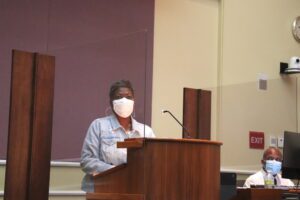As soon as County Attorney Willie Darby began a public hearing to decide the fate of thousands of cats in Durham on the night of July 11, it was clear where most people stood: A majority of the nearly 40 people in attendance nodded as he read off proposed amendments to the Durham County Animal Control Ordinance. With teary eyes and shaky voices, proponents of the changes persuaded the County Board of Commissioners to unanimously pass the amendments, 5-0, all but outlawing euthanasia for community cats.
Highlights of the changes to the ordinance include establishing a TNVR program (trap, neuter, vaccinate and return) for abandoned and stray cats—now legally known as community cats—which would be euthanized only if they’re sick and unlikely to recover. Under the changes, non-profits would administer the program.
“What we’re doing now, it’s just — it’s not working,” said Wendy Jacobs, vice chair of the Board. “We need to do something different; this is a community problem that needs a community-based solution. I really look forward to the next steps.”
The amendments’ supporters argue that administering neutering and vaccination services to community cats will reduce their population. Anything short of this is inhumane, they say. Opponents are unsure whether the legislation will fulfill its purpose, arguing that ending euthanasia and trap programs could harm the local bird population, as cats are predators.
Currently, there are nearly 60,000 community cats in Durham, Jacobs says. The cost of euthanizing them all would be $120 million. The county spent $70,000 in 2021 on euthanizing around 350 cats.
“This is not something that we’re gonna solve tonight. It’s not something that can be solved in one ordinance,” said the hearing’s first speaker, Danielle Bays, a senior analyst for Cat Protection Policy at the Humane Society of the United States. “But it’s not going to be solved by continuing down the path that Durham is on now.”
Handgun in her pocket and hair in a bun, Lt. Wendy Pinner, of animal services at the Durham County Sheriff’s Office, matter-of-factly told the audience that her department traps animals only when Durham County residents request removal from their property. And because they recently paused the animal trapping program due to overcrowding at the Animal Protection Society shelter, she has had many “frustrated” and “angry” citizens come into her office.
“We had one address in Treyburn [a neighborhood in north Durham] where we received 171 calls for services to trap animals,” she said after stressing that the sheriff’s office is not staffed to carry out trapping.
Andrew Hutson, Vice President of the National Audubon Society and Executive Director of Audubon North Carolina, and Barbara Driscoll, president of New Hope Audubon Society, also opposed the amendments.
Hutson, who represented 2,000 members of the Audubon Society in Durham, said that the trapping and vaccination program “fails on all accounts” because it is “nearly impossible for 100% of cats to be trapped and vaccinated.” He added that “cats also have toxoplasmosis” — a disease that comes from a parasite found in cat feces — and kill more than two billion birds yearly in the U.S.
Driscoll restated Hutson’s claims that the programs have failed to reduce populations and added that it makes “abandonment by pet owners easier.” She worried that these efforts would make it harder to have a “more bird-friendly Durham.”
On the other side, Shafonda Allen, executive director of the Animal Protection Society of Durham, a local shelter, told the Board how much work the community is willing to put into protecting these cats.
For instance, Susan Elmore, a veterinarian for Independent Animal Rescue (IAR), a local non-profit that provides homes for unwanted cats and dogs, is already helping cats for free. (She was among those who spayed and neutered roughly 1,500 cats at IAR and at Orange County Animal Shelter and Durham County Animal Shelter last year.)
“We realized now the reality is that we have these community cats. But if we spay and neuter, their numbers will go down,” Elmore, a veterinary anatomic pathologist in Chapel Hill who attended the public hearing, said in an interview with The 9th Street Journal. “And we have seen this done successfully in many counties in North Carolina and in many states in the country. So this isn’t new ground that we’re breaking, you know, this is a tried and true method of taking care of the community cat population.”
Before Allen’s two minutes were up, she asked everyone in the room, “who is in support of the Animal Welfare Committee’s ordinance changes to allow TNVR in Durham” to stand. The majority of the room stood up.
“These are your citizens; these are your voters,” Allen said. “Everyone here is willing to do something to help with this problem. They notice this doing more, not less. And for every person that calls, that wants them just removed and doesn’t know they will die, there are more who are willing to help them.”
Above: Shafonda Allen, executive director of the Animal Protection Society of Durham, testifies before the Durham County Board of Commissioners on July 11th. Later in the evening, a majority of the audience stood up to indicate their support for ending euthanasia for abandoned and stray cats. Photos by Ana Young–The 9th Street Journal.






